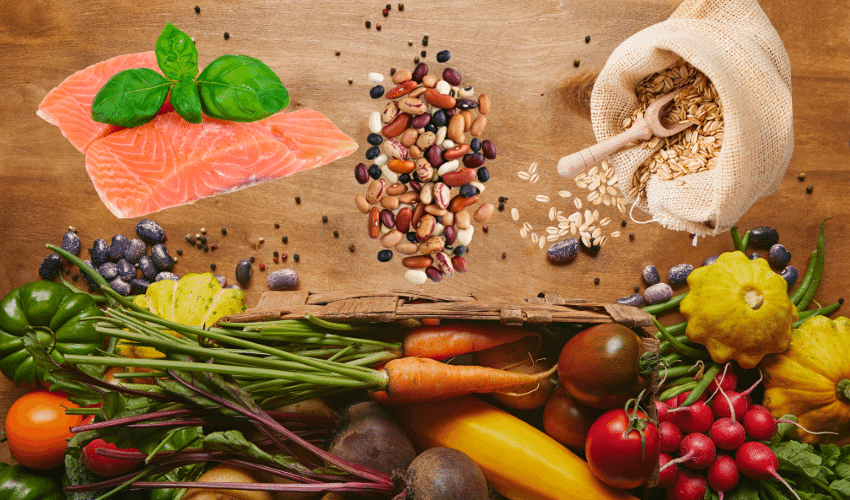As with everything, the idea of a Whole-Food Plant-Based (WPFB) diet comes with some misconceptions. The name, Whole-Food and Plant-Based, seems to give the idea that you must be a vegan or vegetarian to follow a WFPB, when nothing could be further from the truth.
Unlike other diets, WFPB diets and nutritional patterns are more about what they can include rather than what they exclude.
Vegans, for example, exclude meat and animal by-products from their diets and a diet like the Atkins Diet focuses on the types of carbohydrates you can eat, this diet is more about limiting the amount and the types of carbohydrates you eat.
WFPB diets are marked by what they include, which are plant based and whole foods. This implies that plant-based foods are preferable, and perhaps should be the main source of your diet, however, whole foods are the other part of that.
Fresh caught salmon is a whole, nutrient dense food. Rather than focusing on the implication of a WFPB diet being that you must exclude meat, take a look at what you can include and decide for yourself.
When Followed Correctly, They Are All WFPB
Pescatarians, Vegetarians, the Mediterranean diet, and even the Ketogenic Lifestyle are all WFPB diets when done right.
Now, before the Vegans and Vegetarians in the room start cringing over that last one, let’s clear something up.
Not all Vegetarian, Mediterranean, Pescatarian, and Ketogenic diets are necessarily WFPB either. After all, sodas and bags of deep-fried potato chips carry that vegetarian or vegan stamp. These highly processed foods also contain preservatives, additives, and added sugars.

What's The Point?
The point of a WFPB diet isn’t to avoid meat. Remember, this isn’t one of those exclusionary diets. The best place to start is to fill your diet with whole, nutrient dense, and plant-based foods.
Strawberries are whole foods, they’re nutrient dense, and they’re plant based.
However, chicken breasts are whole nutrient dense foods too, so someone interested in following a WFPB diet without being a vegan or vegetarian definitely can.
Meat can be added as long as you stick to fresh or frozen unprocessed meats.
The WFPB concept is to add more healthy, and nutritious foods to your diet.
Yes, the words run together to imply a plant-based diet of whole foods, when, in-fact, you’re looking for whole foods and plant-based foods. If a food item meets both qualifiers, then that’s great.
One of the major myths running around about WFPB diets is that they’re carb heavy. This is true. This is also okay.
Carbohydrates, especially complex carbs, aren’t necessarily the enemy. The thing you want to avoid are the foods containing simple sugars, like sodas and candy, which will cause your blood sugar to skyrocket and then plummet.
This is the sort of thing which has been giving carbohydrates a bad name, but the fact is that your body needs carbs to burn as fuel. There’s nothing wrong with complex carbs.
Here are some of the foods with complex carbs:
- Whole grains (brown rice, wild rice, oatmeal, barley and bulgur wheat)
- Quinoa and Buckwheat
- Beans
- Peas
- Vegetables
- Sweet potatoes and Winter squashes
With that said, a Ketogenic Lifestyle can be designed around a WFPB option.
In fact, most usually are, it’s just that people on this diet need to burn ketones rather than glucose, or want to, for whatever reason. There are plenty of plant-based options for dietary fat, like avocados and olives, which meet the Whole-Food requirement.
The Bottom Line Of WFPB Eating
The bottom line is that WFPB diets aren’t about which fuel you burn, or whether you eat meat or not. They’re about including as many types of whole foods into your diet as possible.
Focus on eating nutritious, nutrient dense, whole, and plant-based foods instead of the highly processed foods most of us reach for more often than we should. I’m talking junk foods like T.V. dinners, candy bars, chips and other processed foods that contain way too many things we don’t need, like sugars, salt, preservatives.
More To Discover
Sure, those foods taste great because they’re designed to, but that doesn’t mean they’re good for you.
Find the version of WFPB diet that suits your lifestyle, whether you want to be a vegetarian or not, there is one that will let you be in your best health. A list of the foods eaten in the diets mentioned here is provided below.
FOODS EATEN IN THE DIETS MENTIONED ABOVE:
- Vegan Diet – Eat fruits, vegetables, whole grains, legumes, nuts, seeds, tofu, tempeh and seitan. They eat absolutely no meat, dairy, eggs or meat based foods.
- Vegetarian Diet – Eat fruits, vegetables, whole grains, legumes, nuts, seeds, tofu, tempeh, seitan and some milk, cheese, yogurt and eggs unless following the Lacto-ovo version of the diet.
- Mediterranean Diet – Eat whole grains, vegetables, fruits, legumes, nuts, seeds, olive oil, fish, seafood, dairy and poultry in moderation. Red meat and sweet are only eaten occasionally.
- Pescatarian Diet – Eat fruit, vegetables, whole grains, legumes, nuts, seeds, eggs, dairy, fish and seafood. They don’t eat meat or poultry.
- Keto Diet – Eat Meats, fatty fish, healthy fats, low-carb vegetables, full fat dairy and eggs.
- Atkins Diet – Eat Meats, fatty fish, Eggs, full fat dairy, nuts, seeds, healthy fats and low-carb vegetables.















